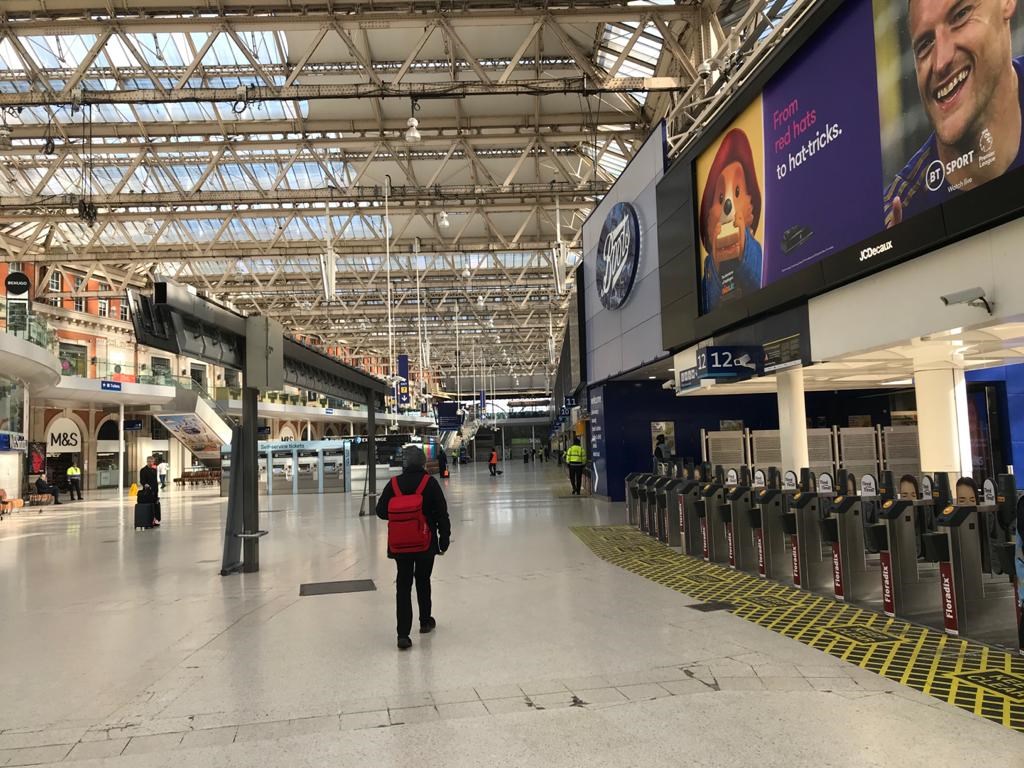Wednesday 8 Apr 2020
London stations see passenger numbers fall by over 90% during the COVID-19 pandemic
- Region & Route:
- Southern: Wessex
Network Rail has issued a heartfelt thank you to passengers for heeding Government advice to stay home after new figures reveal footfall is down an average of 93% at some of London’s busiest stations.
The data shows a dramatic decrease in passengers at the some of the main commuter hubs in Network Rail’s Southern region, including London Waterloo, Victoria, Cannon Street and London Charing Cross, since the Government advised the public not to travel unless essential on 16 March.
Footfall has fallen across the stations managed by Network Rail Southern region by around 93% on weekdays, rising to 96% during weekends.
London Waterloo has seen the biggest decrease in footfall with a 95% reduction compared to the 94.2 million annual journeys, or around 125,000 journeys that are made through the station on an average weekday.
Fewer passengers allows safer journeys for those unable to work from home, including frontline rail workers.
|
Station name |
Average decrease in footfall at each station between 30 March – 5 April, compared to 16 March |
Annual passenger numbers (estimated) |
|
Waterloo |
95% |
94.2 million |
|
Victoria |
93% |
74.7 million |
|
Cannon Street |
93% |
30.2 million |
|
Charing Cross |
92% |
20.6 million |
Network Rail is urging anyone who is making non-essential journeys to stop doing so immediately.
Passengers who cannot work from home and do need to use the railway should continue to check before travelling by visiting www.nationalrail.co.uk or checking with their train operator.
John Halsall, managing director for Network Rail’s Southern region, said: “The figures show a dramatic decrease in passengers travelling through London commuter hubs and I’d like to thank everyone who is following the government advice and only travelling when it is absolutely necessary.
“The railway has been designated as a key service for the country so must remain open to ensure that those who can’t work from home, can get to work, while rail freight must continue to carry essential medical supplies to hospitals and food to supermarkets.
“While it might be unusual to thank people for not travelling, this is an unprecedented situation. I want to urge people to stop travelling if they don’t need to and continue to follow the guidelines so that more lives can be saved.”
Rail Minister Chris Heaton-Harris said: “I am delighted to be in the unprecedented position of thanking people across the country for joining together to stay home, protect the NHS and save lives, and avoid using our railways.
“Figures show that footfall at Waterloo, Victoria, Cannon Street and Charing Cross have decreased significantly - a fantastic sign that people are listening to the advice to stay home wherever possible.”
Notes to editors
Notes to Editors
*% calculated using number of people who have entered and exited the four London stations on 16 March, versus an average of total footfall the week 30 March-5 April (inclusive).
Station usage estimated based on ORR figures
Contact information
Passengers / community members
Network Rail national helpline
03457 11 41 41
Latest travel advice
Please visit National Rail Enquiries
Journalists
Martin Spencer
Martin.Spencer2@networkrail.co.uk
About Network Rail
We own, operate and develop Britain's railway infrastructure; that's 20,000 miles of track, 30,000 bridges, tunnels and viaducts and the thousands of signals, level crossings and stations. We run 20 of the UK's largest stations while all the others, over 2,500, are run by the country's train operating companies.
Usually, there are almost five million journeys made in the UK and over 600 freight trains run on the network. People depend on Britain's railway for their daily commute, to visit friends and loved ones and to get them home safe every day. Our role is to deliver a safe and reliable railway, so we carefully manage and deliver thousands of projects every year that form part of the multi-billion pound Railway Upgrade Plan, to grow and expand the nation's railway network to respond to the tremendous growth and demand the railway has experienced - a doubling of passenger journeys over the past 20 years.
Follow us on Twitter: @networkrail
Visit our online newsroom: www.networkrailmediacentre.co.uk

